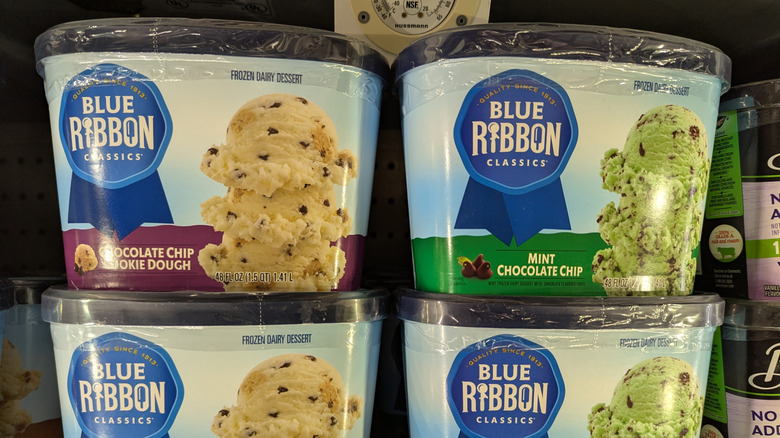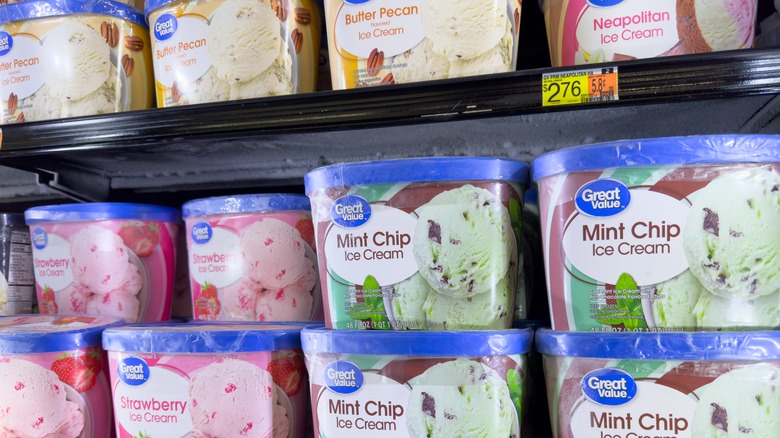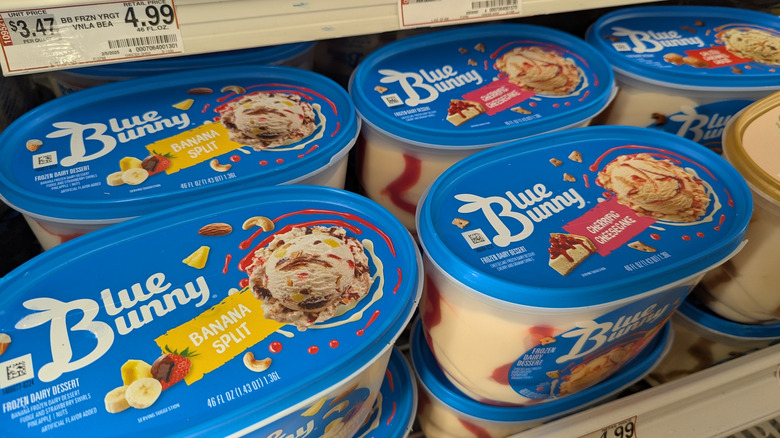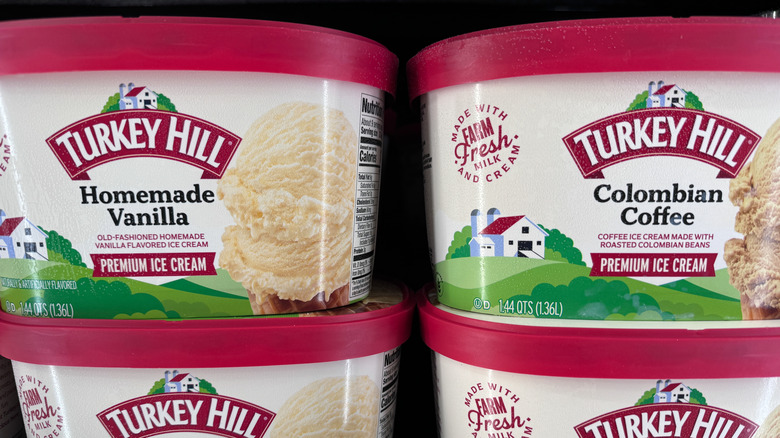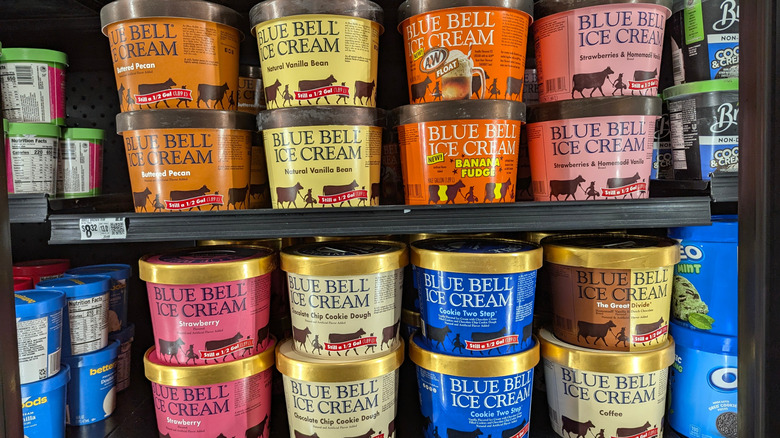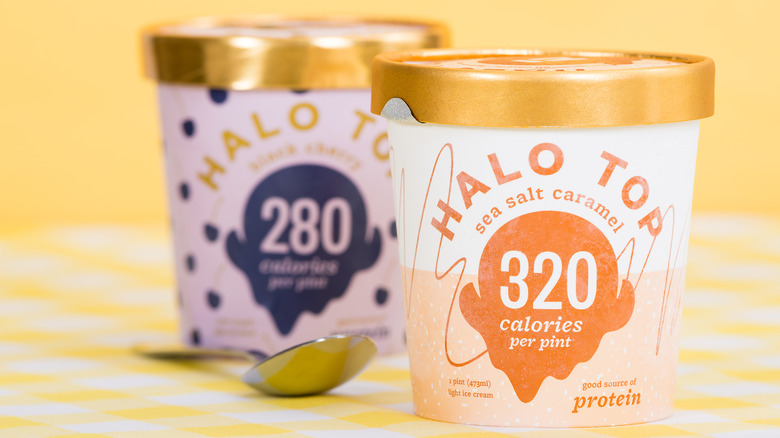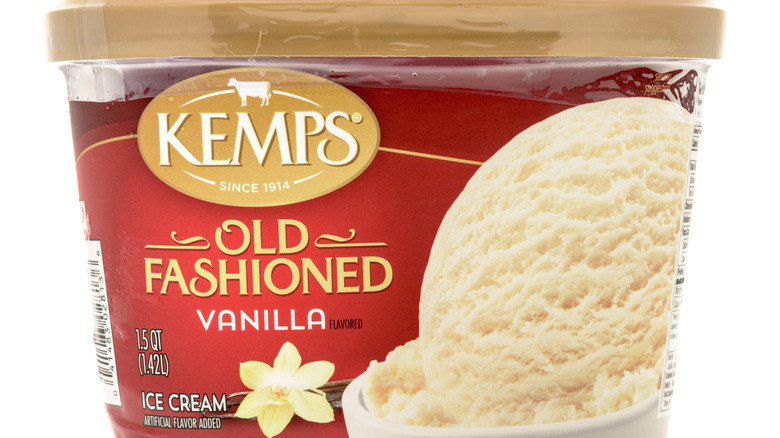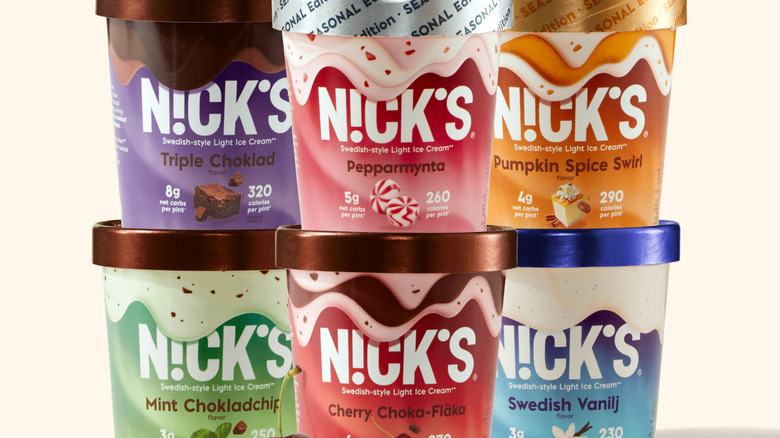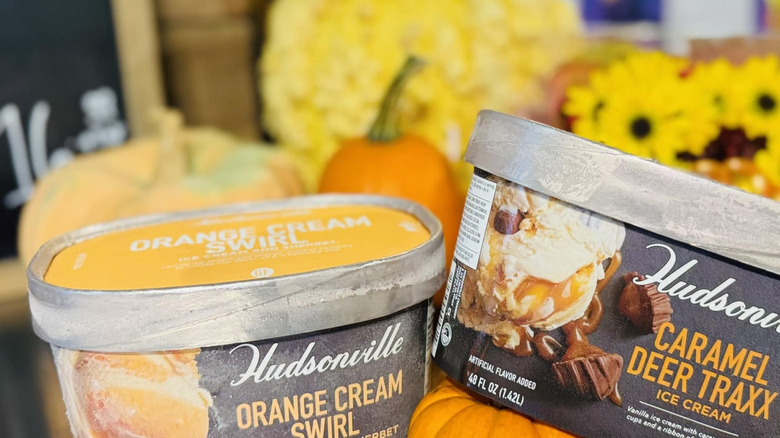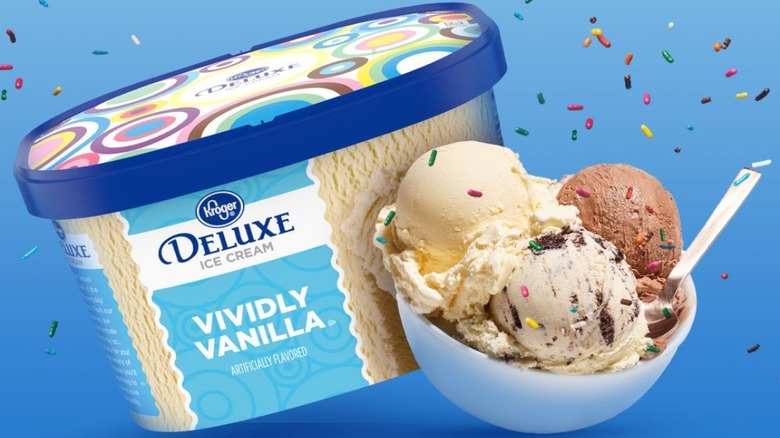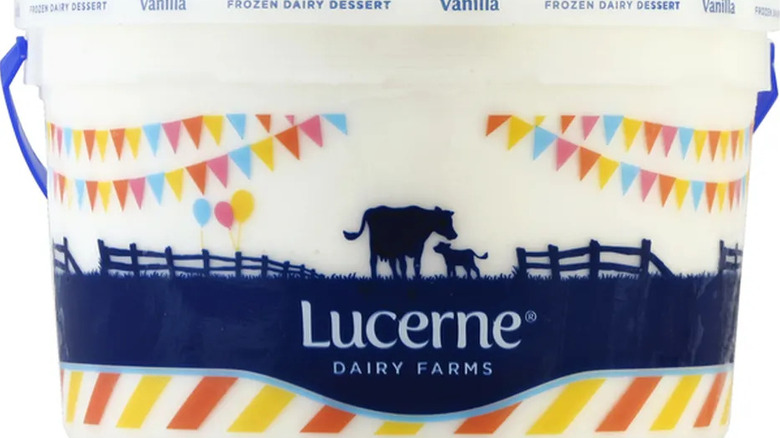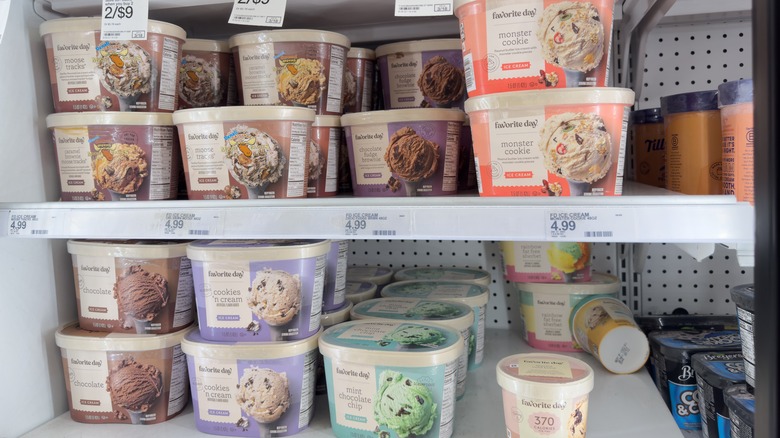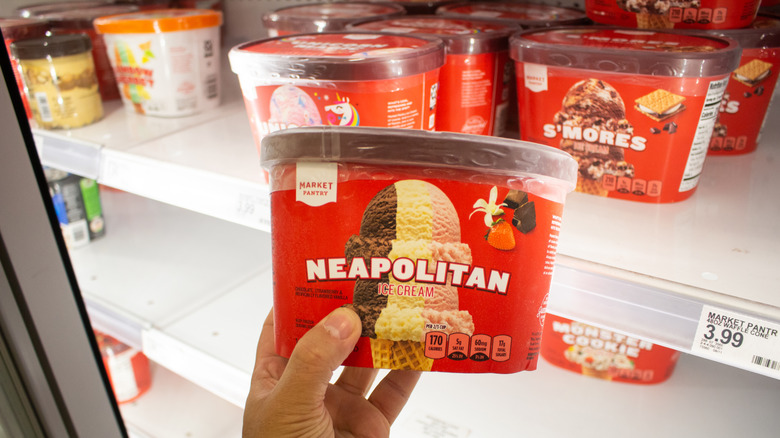13 Ice Cream Brands That Use The Lowest Quality Ingredients
At its core, ice cream is made up of only a few simple ingredients: milk, cream, sugar, and flavor. Higher quality ice creams won't skimp on these items, using real flavorings like mint oil or vanilla bean in lieu of their artificial counterparts. Brands like Salt & Straw may even take it a step further and use ingredients such as cheese, bacon, and turkey to amp up the gourmet factor.
However, the cost of these ingredients is reflected in the price of the pints, which can mean that they're more of an occasional indulgence than a regular grocery store pick-up. Instead, many shoppers turn to cheaper brands to get their ice cream fix (especially in light of ice cream being a recent victim of shrinkflation). After all, even bad ice cream is still ice cream, right?
Not necessarily. Where consumers save on money they may be paying the price in their health. Lower quality ice creams like the ones listed below cut corners by using cheaper ingredients that may be damaging to our bodies, as some of these ingredients are linked to heart disease, digestion issues, possibly cancer, and more. Read on to get the inside scoop about what grocery store staples are using the lowest quality ingredients –– at the expense of your health and taste buds.
Blue Ribbon Classics
While the name "Blue Ribbon Classics" implies that this line of ice cream is best in show, one peek at the ingredients list will have it toppling off the podium. Like others on this list, Blue Ribbon Classics can't even be called ice cream, as they don't have the requisite amount of milkfat, which is a minimum of 10%, according to the International Dairy Foods Association. (The same applies to Dairy Queen's soft serve.) Instead, they're labeled as "frozen dairy desserts" –– and artificially flavored ones at that.
While other brands use real vanilla flavor (you can even create your own), vanilla bean paste, or ground vanilla beans to flavor their ice cream, Blue Ribbon Classics is firmly entrenched in artificial flavor. If you ask us, "artificially flavored frozen dairy dessert" simply doesn't have the same ring to it as "vanilla ice cream." Alongside the artificial flavor, Blue Ribbon Classics further tries to stretch the definition of ice cream –– and your dollar –– by filling their cartons with pretty cheap ingredients. Corn syrup, fructose, carob bean gum, cellulose gum, tara gum, xanthan gum, guar gum, and added color all work to make this look like ice cream, but certainly not taste like it.
Great Value
Is there really any great value involved when you're hoping to enjoy a silky smooth scoop of ice cream and end up with a bowl of Walmart's store brand? We say no, and one look at the ingredient list will show you why. While Great Value ice cream can legally be called ice cream, owing to it reaching the minimum threshold of 10% milkfat, that's about where the compliments for this ice cream end. Great Value does contain the classic ice cream ingredients of cream and sugar, but it also uses corn syrup, a cheaper alternative.
To help stabilize the ice cream, Walmart has also added gums like cellulose gum, carob bean gum, and guar gum. Thickeners like carob bean gum can lead to intestinal discomfort and can also impact the body's absorption of iron, calcium, and zinc. Great Value brands also rely on added color and artificial flavor to make it taste the way it's marketed, without having to cough up the money required to use the real stuff. The lack of actual vanilla in the brand's Homestyle Vanilla variety leads it to package this ice cream as "vanilla-flavored," lest you think you're getting the real deal.
Blue Bunny
Another ice cream that (technically) isn't, is Blue Bunny. The cheery brand counts plenty of fun flavors in its roster, including Super Chunky Cookie Dough, Peanut Butter Party, and the adorably Bunny Tracks, but that's really where the positives end –– at least when it comes to high quality ice creams.
Another "frozen dessert," Blue Bunny's use of cream is way down the ingredient list, with skim milk and whey forming the bulk of this grocery store staple. Blue Bunny does use sugar in its products, but it bolsters the higher cost of the sweetener by using cheaper alternatives, specifically corn syrup and high fructose corn syrup. To help tie all that skim milk and whey together, Blue Bunny relies on thickeners like tara gum, guar gum, carob bean gum, cellulose gum, and xanthan gum. Finally, it's the artificial colors that have us leaving Blue Bunny on the shelf: In their Cherry Chocolate Chunk flavor, for example, customers will find Red 40, Blue 1 and Blue 2. Red 40 has been linked to migraines and hyperactivity in adults and children, while Blue 1 can cause allergic reactions and some studies show many food dyes may be carcinogenic.
Turkey Hill
When looking at Turkey Hill's list of available ice cream flavors, we found ourselves positively salivating at the sight of them. After all: Brown Sugar Bourbon Vanilla? Chocolate Lava Cake? Cookie Butter? No wonder they're such a hit in the freezer aisle. But let's take a closer look at some of the ingredients actually listed on the side of these generous cartons.
Take the afore-mentioned limited edition Brown Sugar Bourbon Vanilla flavor, for example. One would expect, naturally, brown sugar, bourbon, and vanilla, or a bourbon vanilla, to be listed among these ingredients. Shockingly, this ice cream actually contains none of the above. While there is sugar, and even brown sugar nestled in the blondie chunks found in the ice cream (although not the ice cream itself), there is also corn syrup and high fructose corn syrup. And, perhaps even more disappointingly, there is no bourbon or bourbon vanilla, either. Instead, consumers are treated to artificial flavors, none of which specifically calls out vanilla –– natural or otherwise.
Blue Bell
A quick Google search of Blue Bell Ice Cream will reveal the tagline "The Best Ice Cream in the Country." That's a pretty lofty goal from a brand that boasts nationwide availability, especially when so many small-batch, high-quality creameries exist. A smaller scale operation means more attention can be paid to the ingredients and the quality. As such, smaller brands that do manage to stretch across the country tend to cost a fair bit more than your standard tub of Blue Bell.
Compared to others on this list, Blue Bell isn't especially egregious when it comes to their ingredients. One look at their Homemade Vanilla flavor — which the brand claims has a "special, hand-cranked flavor" –– and we see milk, cream, and sugar as the top ingredients. So far, so good. Further on, however, we run into the usual culprits: high fructose corn syrup, vegetable gums, and artificial flavors. Artificial colors –– like Yellow 5 and Blue 1 –– also make an appearance in other flavors, such as Mint Chocolate Chip. While we might pick up a tub or two of Blue Bell on occasion — since it's not the worst offender on this list — it won't be that often.
Halo Top
Let's get one thing straight off the bat: Halo Top is questionably ice cream –– due to what the FDA considers ice cream. While the brand likes to bill itself as "light ice cream, it simply doesn't have enough milk fat to legally be called so. Despite this, it must have done some legal wizardry because "light ice cream" is what's on the sides of each adorable pint, thus making it acceptable to include in this list.
While the pints are pretty cute –– and marketed as a single serving, with the calorie count front and center –– the list of ingredients from Halo Top is a whole lot less appealing. Take their Strawberry flavor – a product the brand touts as a "fan favorite" — for example. In its 270-calorie pint, Halo Top saves on calories by using sugar substitutes like erythritol and stevia. Erythritol can cause nausea and heart problems while stevia can cause digestion issues like bloating, cramping, and nausea. As a point in their favor, however, Halo Top does use real fruit and natural coloring in their products, so we will give credit where credit is due.
Kemps
In operation for over 100 years, Kemps has been slinging scoops since 1914. Dairy farming is at the core of the brand, which also produces milk, sour cream, yogurt, and cottage cheese as well as ice cream. With such a focus throughout their marketing materials on natural milk and dairy, one can expect a similarly simple ingredient list. Alas, that is not the case.
Like many other lower-priced brands, Kemps relies on plenty of low quality and artificial ingredients to increase its bottom line. For example, in their Neapolitan ice cream, Kemps uses three kinds of sugar, in addition to a sweetened strawberry puree: liquid sugar, high fructose corn syrup, and corn syrup. While liquid sugar is just sugar and water and typical of ice cream, the two corn syrups are less desirable. Alongside these cheaper sugar substitutes is artificial color and flavor. To get the perfectly pink hue of the strawberry segment of Neapolitan (not to be confused with spumoni), Kemps does what Halo Top did not: use artificial dyes, specifically Red 40 and Blue 1. As previously mentioned, these food dyes can cause allergic reactions and may be a cause of hyperactivity in adults and children.
Nick's
Similar in style to Halo Top, which bills itself as a source of protein and encourages consumers to enjoy the whole pint guilt-free, newcomer brand Nick's stands out by marketing itself as a light ice cream. The Swedish company launched in 2016 and, in addition to ice cream, also offers protein bars and keto bars. Developed out of creator Niclas Luthman's diagnosis of pre-diabetic, the brand eschews the typical ice cream ingredients in favor of ones that adhere to this lifestyle.
Part of the beauty of real ice cream is its simple list of ingredients, like milk, cream, and sugar. When you choose a lower-calorie option such as Nick's, what you end up gaining instead is a laundry list of ingredients that have no right to belong in ice cream. In Nick's Birthday Cake flavor, you won't find high fructose corn syrup, but you will find erythritol, allulose, and steviol glycosides, sugar substitutes that can contribute to digestion issues. The light ice cream also contains palm kernel oil, a common ingredient in margarine and shortening.
If you want ice cream without the fat, sugar, and high calorie count, Nick's isn't a terrible choice, but the list of non-ice cream ingredients has us second-guessing it.
Hudsonville
Right on their homepage, Hudsonville boasts that it has been making "real ice cream since 1926." Of course, that's to make consumers feel secure in the fact that this legacy brand is still making ice cream as they did back in 1926, before mass production became a thing and the cost of ingredients soared.
While Michigan-based Hudsonville isn't the most egregious when it comes to low quality ingredients, the brand could improve in some respects. Take its Super Scoop flavor, a nostalgic delight that blends yellow-colored vanilla ice cream, red-colored black cherry ice cream, and their iconic Blue Moon ice cream (a flavor that's described as both "mysterious" and "indescribable") into a trifecta. Unfortunately, the ingredient list is less enchanting, with corn syrup, artificial flavors, and food dyes Red 40, Yellow 5, and Blue 1 all making appearances. Hudsonville also offsets costs by using corn syrup as well as sugar in its products. While not the worst by any means, we suggest sticking to the brand's more classic flavors that skip the added color, like Classic Chocolate, Double Chocolate Almond, and Vanilla Bean.
Kroger Deluxe
Let's say it now: Store brands are unlikely to be high on the list of quality ice creams. The savings they bring to consumers tends to come at the cost of quality and ingredients. This is the case for Kroger Deluxe ice cream, which can be found in the popular grocery chain's stores. While it might be considered a steal at a mere $2.99 for a whopping 48 ounces, we don't know how much of a bargain we're getting when we see an ingredient list that's packed full of stabilizers and sugars.
Alongside the classic milk, cream, and sugar, Kroger has also added corn syrup and high fructose corn syrup. High fructose corn syrup has a higher amount of fructose, a sugar that takes the body longer to break it down. Consumption of too much high fructose corn syrup has been linked to obesity, diabetes, and heart disease. Kroger Deluxe ice cream also tries to bulk out its cartons with the addition of guar gum, cellulose gum, and locust bean gum, not to mention the artificial flavor used to save money that should be spent on the real stuff.
Lucerne Dairy Farms
Another ice cream brand that cannot be legally called ice cream due to not meeting the requisite percentage of milkfat in its products, Lucerne Dairy Farms offers customers a "frozen dairy dessert." With sugar as the second ingredient in a container of the brand's vanilla frozen dairy dessert, one wonders why, then, is corn syrup the fourth? To us, it sounds like a way to mask cheap ingredients by overloading the palate with too much sugar. A Reddit poster unhappy with the brand's offerings complained that the vanilla flavor was lacking in, well, vanilla, and that the taste was predominantly sugar and nothing more.
This product includes stabilizers like locust bean gum, guar gum, and carrageenan. Carrageenan is a common food additive that has been linked to digestion and bowel issues, and may even be linked to colon cancer, which is another reason you might want to skip this frozen dairy dessert. Alongside artificial flavor and added color, don't be fooled by the bucolic pair of farm cows on the brand's logo: This stuff isn't nearly as natural.
Favorite Day
A store brand strikes again, this time from Target. While Favorite Day has plenty of fans, it unfortunately fails to live up to expectations when it comes to ice cream. While we're certainly intrigued by the flavors offered by the brand, especially current seasonal offerings like Spicy Lime Margarita and Peach Cobbler, we do balk at some of the ingredients that can be found on even their more classic options. Take, for example, the vibrantly hued Mint Chocolate Chip. While you can imagine that a seafoam green ice cream is made with artificial colors (Blue 1 and Yellow 5, to be exact), Favorite Day also falls victim to using three kinds of sugar in its mass-produced ice cream: liquid sugar, corn syrup, and high fructose corn syrup. High fructose corn syrup is linked to a myriad of health issues and is best avoided whenever possible.
The brand also relies heavily on artificial flavors rather than real ingredients to flavor its ice cream. While we might be persuaded to try their seasonal flavors (in the name of science, of course), the low quality of these ingredients mean they won't become part of our regular grocery shopping.
Market Pantry
Yes, Target appears here again, this time with another store brand: Market Pantry, the longest-running member of the shopping giant's in-store labels. While Favorite Day is a little younger, hipper, and fresher (and thus might convince you of its quality), Market Pantry is a little more traditional. In fact, in recent years, Market Pantry has been scaled back in favor of the company's Good & Gather brand, the third name under Target's banner.
However, there are still some ice creams under the Market Pantry name, just not very good ones. The vanilla flavor of Market Pantry's light ice cream is almost boring in its list of ingredients, so often have we seen these repeat offenders: corn syrup, artificial flavor, added color, guar gum, and cellulose gum appear, leading a handful of reviewers to say that the promised vanilla flavor simply isn't there. Vanilla is usually the gold standard when it comes to determining if an ice cream brand is any good, and if Market Pantry fails to live up to that low bar, we'll have to leave it in the freezer and find something better.

